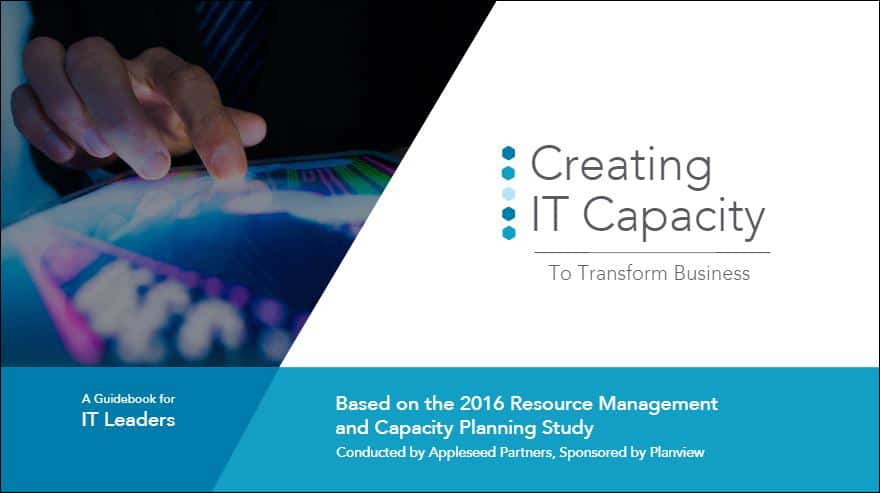
Today’s organizations are challenged to drive innovation and transformation like never before. Savvy PMOs and IT organizations realize that they must go beyond simply completing projects on time and on budget. They must create and drive these innovation and digital transformation initiatives – or at least deliver them – in line with business objectives.
Yet, according to a 2017 Planview survey of more than 220 professionals involved in project and portfolio management functions (including project managers, program managers, the PMO, IT management, and the CIO):
- 73% of organizations report that they don’t have enough resources to meet incoming demand;
- 55% of organizations state that their projects and resources are not well aligned with business goals;
- Less than 30% of PMOs consider their primary goal is to create business value; and
- 49% have seen a project fail in the past 12 months.
These challenges – and the eight trends exacerbating them – are why organizations are increasingly turning to Portfolio and Resource Management software, which enables companies to:
Optimize resource utilization through capacity planning: When change comes, being able to focus the right resources on the highest priorities is the key to making strategy real. Planview’s 2016 State of Resource Management and Capacity Planning Benchmark Study found that companies with higher resource capacity planning maturity are better able to manage shared resources, increase resource utilization, and improve prioritization.
Deliver business value: Portfolio and Resource Management enables organizations to understand the “why” behind project requests, track business KPIs, and ensure their resources are focused on delivering what is most important.
Here are four examples of how organizations are overcoming their specific portfolio and resource management challenges and achieving business outcomes.
Global Retailer Saves $4.6 Million by Optimizing Projects and Resources
With 17,000 points of distribution and a presence in 40 countries, this clothing retailer made it a strategic and operational priority to revamp its IT project and resource management to enable continued growth. It identified five challenges to solve:
- Minimal Project Tracking and Governance: IT had
 multiple project lists maintained separately by the varying business units with no governance in how to select or create projects. There was no tracking of project costs or resource requirements.
multiple project lists maintained separately by the varying business units with no governance in how to select or create projects. There was no tracking of project costs or resource requirements. - Project Priority: Managers had no way to identify which projects were the most valuable.
- Capital Labor Tracking: IT labor was being expensed on software projects that depreciated over multiple years. There was a mismatch of project costs, and auditors were concerned about improper annual expenses.
- Compare Time Between Workgroups: Each workgroup had a different set of “run the business activities,” creating more than 100 different activity types. There was no way to determine how IT personnel were actually spending their time.
- Future Requirements: Several groups were involved in almost every project with minimal coordination between projects. It was impossible to forecast resource capacity issues, creating constant unforeseen resource conflict issues.
The company is addressing these challenges and supporting business growth with their Planview solution. They have improved prioritization of work and resources with a six-to-12-month view of resource planning activities. They have also advanced lifecycle and project management processes for improved project delivery. By aligning resources to highest value projects, the organization has seen more than $2 million in capital savings and $2.6 million in expense savings.
“We finally have a handle on our resource capacity and demand,” said the senior PMO director. “We can now say with confidence what our resources are working on and when we need to start supplementing with additional resources to keep projects on schedule. The next 6-12 months, we still have a good level of accuracy so we’re no longer scrambling to find contractors. Instead, we can proactively look at our contractor pool, build those relationships and better determine what skill set we need.”
Global Insurer Gains Enterprise-wide Visibility and Governance
For one of the world’s largest insurance providers, IT project management was a massive endeavor. With multiple project management offices and 600 project managers, the global IT division needed to consider language barriers as well as time zone, currency, and process maturity differences across the business units. An audit of every project management, resource management, demand management, and time tracking tool in use confirmed the complexity of too many disparate systems to manage.
With no consistency and no common language or definitions, the organization decided to consolidate onto a Planview solution of portfolio and resource management. Now, with a single system, they have enterprise-wide visibility and transparency to support decisions relating to spend, strategic alignment, and project and resource management. Since deployment, the company has:
- Overcome the complexity of its size, scale, and maturity levels
- Successfully implemented a shared service model to align all business units with global standards
- Achieved a 90% user adoption rate
“We simplify our business processes and enable each business unit to configure their use of the Planview software and their own reporting while keeping everyone speaking the same language,” said the head of the Global Program Office.
Major U.S. University Consolidates IT Projects 95%
The IT department of a major U.S. university was managing more than 1,700 projects. It needed a systematic approach to the prioritization of IT initiatives, a centralized project and resource management approach, and the ability to gain visibility into in-flight projects and financials – all for improved IT governance.
The university uses their Planview solution to align IT spend with the organization’s mission to increase accountability and optimize fund management, as well as consolidate IT projects. By using the prioritization process to identify redundancy and streamline efforts, the IT department has reduced the volume of projects being managed by 95 percent, from 1,700 to only 76.
“The project management methodology gave us an enhanced IT governance model with the implementation of a centralized project portfolio information system that provides real-time information to stakeholders,” said the assistant director of the Office of IT. “This data promotes visibility and enables our leadership to be accountable and make integrated informed decisions. Portfolio management teams have clear team operating agreements. These teams developed strategic objectives and values, and regularly discuss IT initiatives, prioritize projects, rank investments, and make integrated informed decisions.”
County Government Drives Productivity with Portfolio Management
A US state county’s Information Systems Technology (IST) department had an $11 million-dollar IT budget and $8 to $9 million in active projects but didn’t have a proper and efficient system in place to determine how each IT dollar was spent and the return on investment. Although defined processes were in place, the IST department lacked the visibility to make commitments and take on new projects.
After trying to manage everything via spreadsheets and attempting to build its own portfolio management system, the county chose to deploy a Planview portfolio and resource management solution. This has empowered the Chesterfield County’s IST team to document the status of every project, while driving project management standardization. They now have full visibility and transparency into the entire project portfolio, enabling them to:
- Eliminate three databases, ten years’ worth of spreadsheets and Word documents, and various other systems that were intended to track information but were actually a hindrance;
- Increase productivity, especially at the management level, because of the ability to track all aspects of each project quickly and easily using reports and dashboards; and
- Save an estimated $100,000 per year as a result of better decisions to optimize their project portfolio and gaining efficiencies across the entire IT organization.
The Planview Solution for Portfolio and Resource Management
These case studies show how Planview solutions are enabling organizations of all sizes and maturity to integrate strategy, planning, and delivery to achieve their business goals, even in the midst of change and finite people and financial resources. Using Planview solutions, companies optimize their portfolios, balance capacity against demand, prioritize and execute projects, and manage the underlying financials. Stakeholders can visualize portfolio performance against plans and make decisions that ensure resources deliver the highest value projects.
Planview solutions for Portfolio and Resource Management span PMOs from small business to large enterprises, across every industry. Product lines supporting these solutions include Planview Enterprise for end-to-end portfolio and resource management, Innotas project portfolio management for maturing organizations and Projectplace for collaborative work management. For more information, visit https://www.planview.com/it-ppm-project-portfolio-management/.





